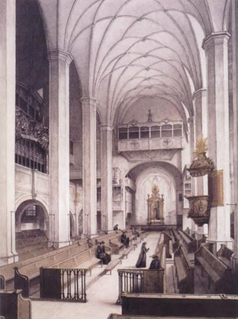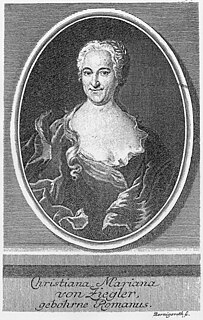| Look up Jesu in Wiktionary, the free dictionary. |
Jesu may refer to:
- Jesus (c. 4 BC – c. AD 30/33), Jewish religious leader and central figure of Christianity
- Jesu (name), vocative and poetic form of Jesus' name
| Look up Jesu in Wiktionary, the free dictionary. |
Jesu may refer to:
The Bach-Werke-Verzeichnis is a catalogue of compositions by Johann Sebastian Bach. It was first published in 1950, edited by Wolfgang Schmieder. The catalogue's second edition appeared in 1990. An abbreviated version of that second edition, known as BWV2a, was published in 1998.

Johann Sebastian Bach composed the church cantata Herz und Mund und Tat und Leben, BWV 147 in 1723 during his first year as Thomaskantor, the director of church music in Leipzig. His cantata is part of his first cantata cycle there and was written for the Marian feast of the Visitation on 2 July, which commemorates Mary's visit to Elizabeth as narrated in the Gospel of Luke in the prescribed reading for the feast day. Bach based the music on his earlier cantata BWV 147a, written originally in Weimar in 1716 for Advent. He expanded the Advent cantata in six movements to ten movements in two parts in the new work. While the text of the Advent cantata was written by the Weimar court poet Salomo Franck, the librettist of the adapted version who added several recitatives is anonymous.

Jesu, meine Freude, BWV 227, is a motet in eleven movements for SSATB choir which was composed by Johann Sebastian Bach. It is named after the Lutheran hymn "Jesu, meine Freude", of which the motet contains, in its uneven movements, all six stanzas of Johann Franck's poetry and various versions of Johann Crüger's hymn tune. The text of the motet's even movements is taken from the New Testament's sixth book, the Epistle to the Romans. The Biblical text, which contains key Lutheran teaching, is contrasted by the hymn, written in the first person with a focus on emotion, and Bach set both in a symmetrical structure. The composition is in E minor. Bach's treatment of the Crüger's melody ranges from a four-part chorale harmonization which begins and ends the work, to a chorale fantasia and a free setting that only paraphrases the tune. Four verses from the Epistle are set in motet style, two for five voices and two for three voices. The central movement is a five-part fugue. Bach used word painting to intensify the theological meaning of both hymn and Epistle texts.
"Jesu, Joy of Man's Desiring" is the most common English title of a piece of music derived from a chorale setting of the cantata Herz und Mund und Tat und Leben, BWV 147, composed by Johann Sebastian Bach in 1723. The same music on different stanzas of a chorale closes both parts of the cantata.

Jesu, der du meine Seele, BWV 78 is a church cantata of Johann Sebastian Bach. He composed the chorale cantata in Leipzig for the 14th Sunday after Trinity and first performed it on 10 September 1724. It is based on the hymn by Johann Rist.

Johann Schop was a German violinist and composer, much admired as a musician and a technician, who was a virtuoso and whose compositions for the violin set impressive technical demands for that area at that time. In 1756 Leopold Mozart commented on the difficulty of a trill in a work by Schop, probably composed before 1646.

Johann Fran(c)k was a German politician, mayor of Guben and a member of the Landtag of Lower Lusatia, a lyric poet and hymnist.

Jesus schläft, was soll ich hoffen?, BWV 81, is a church cantata by Johann Sebastian Bach. He composed it in 1724 in Leipzig for the fourth Sunday after Epiphany and first performed it on 30 January 1724.

Liebster Jesu, mein Verlangen, BWV 32, is a church cantata by Johann Sebastian Bach. He composed the dialogue cantata in Leipzig for the first Sunday after Epiphany and first performed it on 13 January 1726 as part of his third cantata cycle.

Sehet, welch eine Liebe hat uns der Vater erzeiget, BWV 64, is a church cantata by Johann Sebastian Bach. He composed the Christmas cantata in Leipzig in 1723 for the third day of Christmas, which is also the Feast of John the Evangelist, and first performed it on 27 December 1723.

Mein liebster Jesus ist verloren, BWV 154, is a church cantata by Johann Sebastian Bach. He composed it for the first Sunday after Epiphany and first performed it in Leipzig on 9 January 1724.

Bisher habt ihr nichts gebeten in meinem Namen, BWV 87, is a church cantata by Johann Sebastian Bach. He composed it in Leipzig for Rogate, the fifth Sunday after Easter, and first performed it on 6 May 1725.
Freude may refer to:

"Jesu, meine Freude" is a hymn in German, written by Johann Franck in 1650, with a melody, Zahn No. 8032, by Johann Crüger. The song first appeared in Crüger's hymnal Praxis pietatis melica in 1653. The text addresses Jesus as joy and support, versus enemies and the vanity of existence. The poetry is bar form, with irregular lines from 5 to 8 syllables. The melody repeats the first line as the last, framing each of the six stanzas.
A church cantata or sacred cantata is a cantata intended to be performed during a liturgical service. The liturgical calendar of the German Reformation era had, without counting Reformation Day and days between Palm Sunday and Easter, 72 occasions for which a cantata could be presented. Composers such as Georg Philipp Telemann composed cycles of church cantatas comprising all 72 of these occasions. Such a cycle is called an "ideal" cycle, while in any given liturgical year feast days could coincide with Sundays, and the maximum amount of Sundays after Epiphany and the maximum amount of Sundays after Trinity could not all occur.

"Schmücke dich, o liebe Seele" is a Lutheran hymn in German, with lyrics by Johann Franck and a hymn tune, Zahn No. 6923, by Johann Crüger. It was first published in Crüger's 1649 Geistliche Kirchen-Melodien, and was later adopted in other hymnals, such as the 1653 edition of his Praxis pietatis melica.
"Jesu Leiden, Pein und Tod" is a German Lutheran hymn by Paul Stockmann. Written in 34 stanzas and published in 1633, it narrates the Passion of Jesus. It was sung to a melody by Melchior Vulpius. Johann Sebastian Bach used three of its stanzas as chorales in his St John Passion.